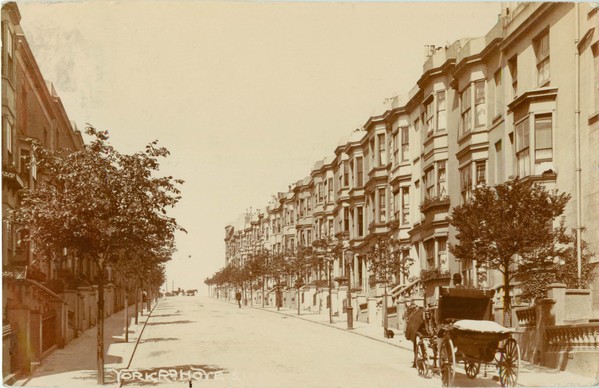Thomas Gimson Foster

York Road, Hove
Brighton and Hove photographer. Foster was born at his parent's house at 3 William Street in the Kingsland district of West Hackney on September 19, 1850. His father, John Foster, was a tailor, born in Nottingham and about 28 years old. Sarah Foster, his mother, also about 28 came from Stroud in Gloucestershire.
William Street does not appear on modern maps of West Hackney. There has been a lot of slum clearance in the Kingsland area, and presumably the street has either been removed or renamed. It may have been situated at the northern end of Kingsland, near Stoke Newington, because Thomas Foster in later life claimed to have been born in Stoke Newington.
Thomas Foster had an elder sister, Mary Ann Foster (born in 1845) and brother, William Foster (born in 1849), as well as four younger siblings: George Foster (born in 1852), Samuel Foster (1858), Alfred Foster (1861) and Ellen Foster (1864). All were born in Kingsland, except Mary Ann, who hailed from Hoxton in Middlesex.
When the 1871 census was held, Thomas Foster was living with his parents at 6 Arundel Road in Islington. He was already working as a photographer, which was to remain his profession for life. His father was still a tailor.
On February 8, 1874 Thomas Foster married Louisa Jane Barwell at St Peter's Church in Brighton. At the time he was living at 9 Montpelier Street, off Upper North Street in Brighton, and his bride was close by at 17 Temple Street. Her late father, William George Barwell, had been a painter. Louisa, like Thomas, was a Londoner. How she came to be living in Brighton is not known.
For a time the young couple lived at Fern House in Goldstone Road in Hove, where their first child, Alfred Thomas Foster, was born on January 27, 1877. A second son, William George Foster, was born in 1880. By 1881 they had moved back to Brighton, to live at 18 Temple Street, perhaps because this street held happy memories for Louisa.
By 1891 Foster and his family had moved to 26 Western Street in Brighton. Two more children had been born: Nellie Isabel L. Foster, in 1885 at Burgess Hill and Mabel Emma A. Foster, in 1890 in Brighton.
By 1895 Foster had settled with his family at 7 Goldstone Road in Hove, which was to remain his home until he died. The 1901 census records that he had begun employing his two sons, Alfred Thomas and William George, as photographers. By 1902 he was running a photographic studio at 38 Preston Street in Brighton and by 1905 a second studio at 26 George Street in Hove. He retired from business and closed both studios around 1910-12. He died in 1923, aged 72.
Although mainly a studio portraitist, Foster published many sepia real photographic cards of Brighton and Hove, as well as a few of more distant places such as Barcombe. The photographs usually lack borders (or have a single basal border) and have handwritten captions in capitals. On some cards the lettering is quite plain apart from occasional small decorative flourishes at the tops or bottoms of certain letters, such as H, R and Y. On other cards, capitals at the start of the captions or at the start of words are enlarged and sometimes awkwardly embellished, as if written by an infirm, arthritic hand. Some cards are anonymous or are labelled "(Foster)" on the front, but fail to mention his address e. g. a card entitled "Wivelsfield Church. (Foster)." Two kinds of card with addresses can be distinguished:
- A few have "Foster, 38 Preston Street, Brighton" discretely blind stamped on the bottom right of the photograph. Postmarks start by the second half of 1906; by 1909 Foster seems to have given up blind stamping.
- A much greater number of cards are labelled on the back: "Photographed & Published by Foster. 38 Preston Street, Brighton, & 26 George Street, Hove". Postmarks start from 1905, if not before, and seem most plentiful from 1907 to 1909.
Three noteworthy cards, issued in 1906, show "Queenie", a miniature Shetland Pony, three years old but only 27 inches high and allegedly the tiniest pony in the world, being paraded by a dark suited man in a top hat in a street thought to be near the east entrance to Brighton Aquarium. Queenie was at one time a prize exhibit at the Aquarium. Also interesting is a card, unfortunately undated but probably from Whit Monday 1910, which shows the start of a Marathon Race from the Court Theatre in Brighton to the Devil's Dyke. In August 1910 Foster issued cards of a parade by Territorials along Hove seafront.
Many of Foster's cards have faded badly over the years and the captions have become very indistinct. Like many publishers of the period he either made mistakes with his fixative or unwittingly selected an unstable type of photographic card.
Thomas Wiles published a coloured card of Hove Station using a photograph supplied by Foster. Foster also collaborated with Francis G. Harwood to run the Brighton View Co..
After Foster's death, his elder son, Alfred Thomas, inherited the Goldstone Road house and lived there with his wife, Emily Louisa Foster.
To directory of publishersTo gallery
Design: Lucid Design
© www.sussexpostcards.info
